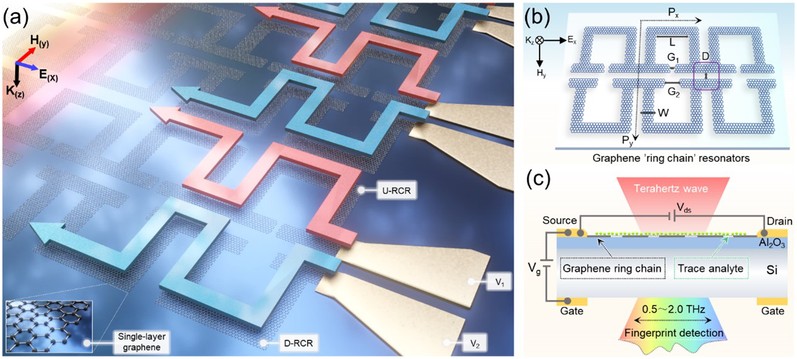Recently, under the guidance of Academician Songlin Zhuang, the THZ Science and Technology Innovation team has proposed a novel single-pixel reconfigurable graphene metasurface design and its multi-functional applications. The research results are entitled "Ultra-wideband terahertz fingerprint enhancement sensing and inversion model supported by Single pixel Reconfigurable graphene metasurface" supported by single pixel reconfigurable graphene metasurface "is published in PhotoniX (Region 1, CAS, Impact factor 16.5). The first author is Dr. Liu Bingwei, and corresponding authors are Professors Peng Yan, Zhu Yiming, and Chang Shengjiang.
Metasurface based molecular fingerprint sensing technology has important research and application value in the biomedical field. However, in the terahertz band, existing metasurface designs based on multi-pixel or Angle multiplexing typically require more samples or have narrower tuning bandwidths. Recently, Peng Yan's group from the School of Optoelectronics at the University of Shanghai for Science and Technology has proposed for the first time a novel single-pixel reconfigurable graphene metasurface design with both synchronous and asynchronous voltage tuning functions. Based on synchronous voltage tuning, the metasurface can achieve ultra-wipeband (~ 1.5 THz) enhanced terahertz fingerprint detection for a variety of trace molecules in a single pixel retrieval scheme, as well as accurate identification of chiral drug optical isomers with detection limit ≤0.64 μg/mm2. Based on asynchronous voltage tuning, the metasurface can achieve dynamic clipping, reconstruction and free slow light modulation of electromagnetically induced transparency (EIT) resonance over a wide band. In addition, a general metasurface fingerprint spectral inversion model is developed, which solves the signal distortion problem of molecular fingerprint retrieval in a wide spectrum range for the first time, and has an ideal fingerprint recovery performance of Rmax2≥0.99.
This work will contribute to the development of a trace molecular fingerprint enhancement sensor platform with features such as convenience, ultra-wideband, low sample size and high resolution, and has important application prospects in the fields of spatial light modulator, optical communication network and high-speed terahertz imaging.

Figure 1. The design concept of reconfigurable graphene metasurface is proposed. (a) Schematic diagram of the graphene metasurface design, where the Fermi level of graphene can be controlled by dual voltage tuning to achieve multifunctional reuse of the metasurface over a wide band (0.5 to 2.0THz). (b) Geometrical parameters of the lattice. (c) Visualization of device architecture.
Article link: Ultra-wideband terahertz fingerprint enhancement sensing and inversion model supported by single-pixel reconfigurable graphene metasurface | PhotoniX | Full Text (springeropen.com)